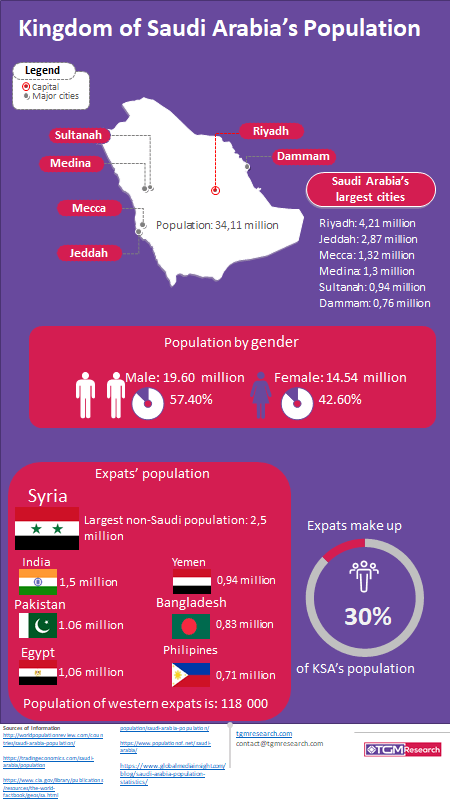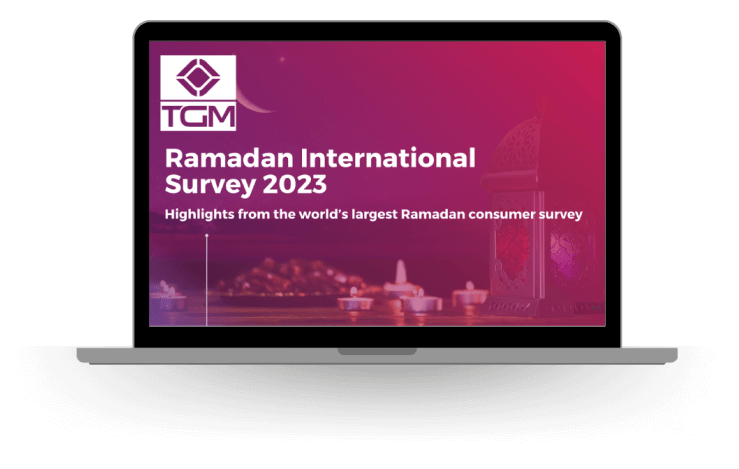Saudi Arabia's Statistics Through a Magnifying Glass (2021)
The Kingdom of Saudi Arabia was founded in 1932 by Ibn Saud, who united four previously distinct regions: Hejaz, Najd, Al-Ahsa and ‘Asir. Several years later, in 1938, petroleum was discovered which led to Saudi Arabia becoming one of the world’s largest oil producers. The population of the country used to be scarce and it was mostly nomadic and semi-nomadic (even decades after the creation of the kingdom). However, significant changes started happening in the 60s. Let us look at KSA's population shift between the recent past and the present, and what kind of factors contributed to having the once nomads settle and live mostly in urban areas.
The population of Saudi Arabia – the history of growth
The Kingdom of Saudi Arabia is the second largest state in the MENA region (North Africa and the Middle East), however, its population – compared to the vast area of the country – is rather small. This is due to geographic and climate factors: the geographic image of Saudi Arabia is dominated by the Arabian Desert. As for the climate, with the exception of the south-western part of the kingdom (Asir province), the country lays within a desert climate area with extremely low annual rainfall, very high temperatures in the daytime and very large daily amplitude (with temperatures falling sharply during the night).
Back in the 50s, the population of the kingdom was estimated at 3 121 335 people. Since the 60s, when a rapid urban and economic development of the country started, there was a stable population growth which became faster in the 80s and 90s. The population density of Saudi Arabia has changed from 4,5 people per km2 in 1980 to 15,3 people per km2 in 2017.
- in 1960 the population of the country was estimated at around 4 million people,
- during the next decade, the growth increased quickly; however, it was not spectacular: in 1970, the population of KSA was estimated at 5,8 million people,
- since the 70s, the population growth sped up quite significantly, to reach 9,7 million people in 1980,
- as mentioned above, it was a decade later that fast population growth was witnessed (with 6,2% annual growth in 1982); in 1990, the population reached 16 million people and the growth stabilized at around half a million annually. At this time, the government realized that the country was becoming overpopulated and started implementing laws that aimed to control and stabilize population growth. As it can be seen on stats, the growth slowed down indeed (1),
- in 1999, the population exceeded 20 million people,
- 2010 – the population was estimated at almost 27,5 million people.
According to the last census, which took place in 2016, the population of the KSA was estimated at 31,7 million people (2). The reported population of KSA as for July 2018, is 33 million people (3). However, the speed of population growth decreased. Currently, according to the United Nation’s data, it is 1,75% annually (4).
In 2019, it is expected that the population of Saudi Arabia would grow by over half a million, reaching 34 710 000 people by 2020. It is important to mention that the rapid increase of population is also caused by migration – migration increases the population of the country by 118 000 people annually (5).
Expats in Saudi Arabia
Overall, 30% of Saudi Arabia’s population consists of immigrants (according to official data). Currently, the total number of non-Saudi citizens within the kingdom’s borders can be estimated at over 10,7 million people. Almost a quarter of them are Syrians (mostly recent migrants, fleeing from war) – there are almost 2,5 million Syrians living in Saudi Arabia, having access to free education and healthcare, they are encouraged to work in Saudi Arabia as well.
The other major nationalities living in the country are:
- Indians (1,54 million, which is 14% of all expats); they are employed mostly at hospitality and mining industries,
- Pakistanis (1,06 million) – mostly low educated workers, taking jobs at construction sites and in other sectors which do not require skilled workers,
- Egyptians (1,06 million),
- Yemenis (0,94 million),
- Bangladeshis (0,83 million),
- Filipinos (0,71 million),
- Sri Lankans, Indonesians, Sudanese, Jordanians, Palestinians, Turks.
Apart from the abovementioned expats from Asian and African countries, there are also over 118 000 people from Western countries currently living in Saudi Arabia (from globalmediainsight.com, 2018, 6).
The Kingdom of Saudi Arabia does not provide residency to foreigners. Foreigners can only get a visa for their stay. When the visa expires, the document must be renewed.
Although the number of expats living in Saudi Arabia seems to be large, the KSA has the lowest percentage of migrant workers among all Gulf states (based on official data, the percentage never crossed 50% of all workers, the real number, however, is probably bigger, if we count illegal immigrants as well).
To be able to obtain a visa to Saudi Arabia, the expat must have a confirmed job before entering the country. The second condition is to have a sponsor, that is a Saudi employer. The expatriate is obliged to work for the sponsor for the duration of his/her stay. If he/she fulfills these two conditions, he/she will able to get a residence permit (“iqama”). If, however, the expat loses the sponsor (and losing the sponsor means losing the job), he/she is obliged to return home.
Population according to age groups and genders
The core of Saudi Arabia’s population consists of people in the middle age group (15-64). This group makes around 64,8% of the total population. As for the children, between 0-14 years old, they make 32,4% of the kingdom’s population. The 65+ age group comprises 2,8% of the population (1).
Back in the 60s, the number of men and women in the country was almost equal. Currently, however, the gender ratio is 140 men per 100 women, which means that there are 18,76 million men and 14,33 million women living in KSA. It is important to add, that the main cause of the imbalance in the gender ratio is immigration. Most of the expatriates searching for work in Saudi Arabia are men, and many of them leave their families in their country of origin for the during of their work contract. Manual Jobs such as construction are also mostly performed by men. However, female expats are present, working in some sectors such as medicine, housekeeping, babysitting and so on.
The biggest disproportion between gender groups is seen in the 25-54 years age group (male population being almost 10 million, while the female one reaching 6,6 million people).
Population by major cities
Around 80% of the country’s population live in ten major urban centres:
- Riyadh – the capital and biggest city, with a population of 4,21 million people; centre of culture, business and industry,
- Jeddah – second biggest city in Saudi Arabia with a population of 2,87 million people; it’s the commercial capital of the country, having the biggest port along the Red Sea and is an important touristic destination,
- Mecca – the third largest city of the country, the holy city of Islam, having a population of 1.32 million people and an economy that is based on the annual Muslim pilgrimage (hajj),
- Medina – the second holy city for the Muslims with a population of 1.3 million people, close to that of Mecca's,
The following list is of cities that have less than 1 million inhabitant:
- Sultanah,
- Dammam,
- Ta'if,
- Tabuk,
- Al Kharj,
- Buraydah.
The urban population in KSA is estimated overall at 83,8% of the total population of the country. Rate of urbanization estimated for the years 2015-20, is 2,17% annually.

Economy and employment
The Kingdom of Saudi Arabia is categorized as a World Bank high-income economy with a high Human Development Index. High-income economies are countries where a gross national income per capita is equal or bigger than 12,056 USD. Gross national income per capita in KSA in 2016 was 53 000 USD, while the estimated value for 2018 was over 55 000 USD. As for the Human Development Index, it is defined as a statistic value composed of such indicators like life expectancy, education and income per capita. The HDI for Saudi Arabia in 2018 was 0,853, which puts the kingdom on the 39th spot in the global ranking, outranking countries like Latvia, Portugal, Bahrain, Chile, Hungary and Croatia.
The Kingdom of Saudi Arabia is currently the biggest economy in the Middle East and the 18th largest in the world. It is the only Arab country in the G-20 major economies.
The country has the second largest proven petroleum reserves and the fourth largest proven natural gas reserves in the world. Saudi Arabia’s economy is petroleum-based (70% of budget revenues and up to 95% of all export come from the oil industry). The kingdom is also an OPEC member.
The work market of Saudi Arabia is strongly dependent on foreign workers. In the private sector, 80% of employees are non-Saudi. The unemployment rate in KSA is stable and averaged at 5,61% from 1999 until 2018. As for 2018 alone, the unemployment rate was 6% in July. The number of unemployed people varies according to the area though, and locally reaches even 12,9%. The so-called “saudization” policy is supposed to fill in 70% of job places in Saudi companies by Saudis, which may partly solve the problem of unemployment among young Saudi citizens. The private sector remains and so far will remain dominated by foreigners though – especially that recent diversification of the economy in KSA attracts expat workers quite strongly.
Quality of life
The average life expectancy in the KSA according to WHO is 74 years for men and 76 years for women (2016). Life expectancy is systematically growing. As for infant mortality rate, it is 12,1 deaths per 1 000 live births (113th place in the world).
The country’s expenditure on health is equal to 4,7% GDP. For every 1000 people, there are 2,54 doctors available.
97% of KSA’s population has access to improved drinking water sources. The entire population has access to improved sanitation facilities.
The risk of HIV infection and AIDS in the country is very low and the reason for that could be attributed to the conservative lifestyle. Currently, only around 8 200 people in the country have HIV infection.
Obesity is considered to be one of the biggest health problems in the country. 35,4% of adults in Saudi Arabia are obese, therefore, Saudis often suffer from diabetes, heart and blood circulation diseases. Saudi Arabia holds 14th place in the world as for its obesity index.
The expenditure on education is equal to 5,1% of GDP. As for the literacy level – 94,7% of the entire population is literate.
The Kingdom of Saudi Arabia is considered to be one of the most conservative countries in the world. As for its economy, it was not diversified – most of the country’s income depends on the oil industry. Recently, however, some changes can be visible in the country’s policy – they include economic diversification, implementation of laws which are supposed to tackle the unemployment problem among young Saudis, enhancing women’s role in society (including their increasing role in the job market). Also, fast-growing digitalization and social media usage boom can be observed – currently over 30 million Saudis use social media on a daily basis.
Understanding MENA part 1
Understanding MENA part 3
Ramadan is coming!
Would you like to know how it will look like this year? Get insights from the world's biggest Ramadan survey.
